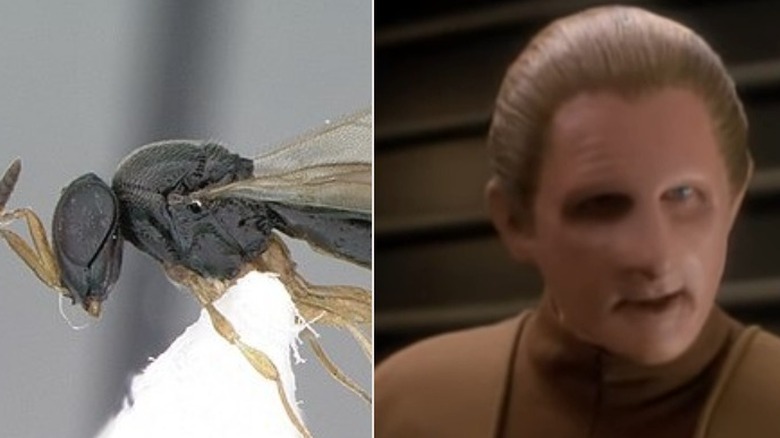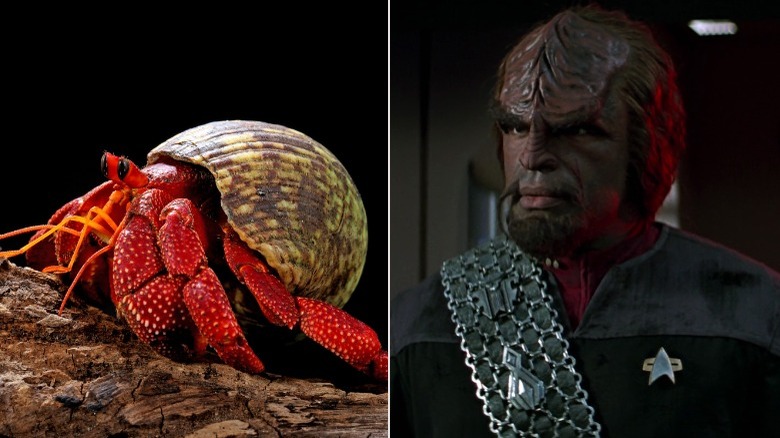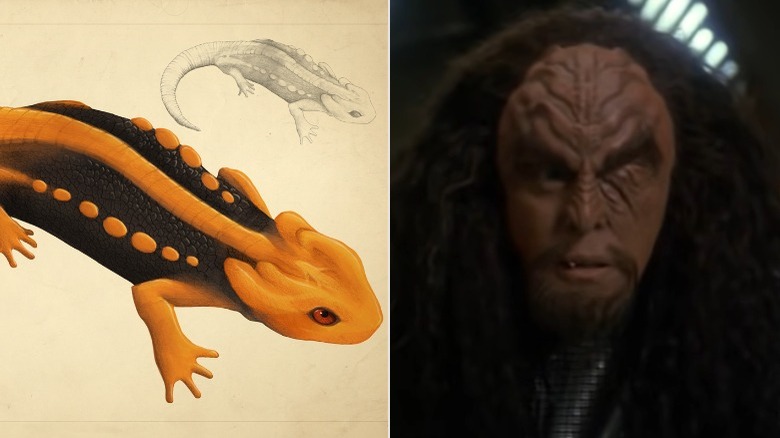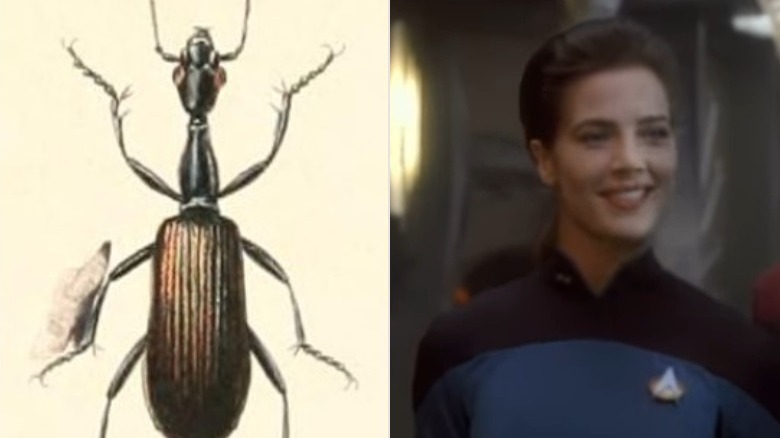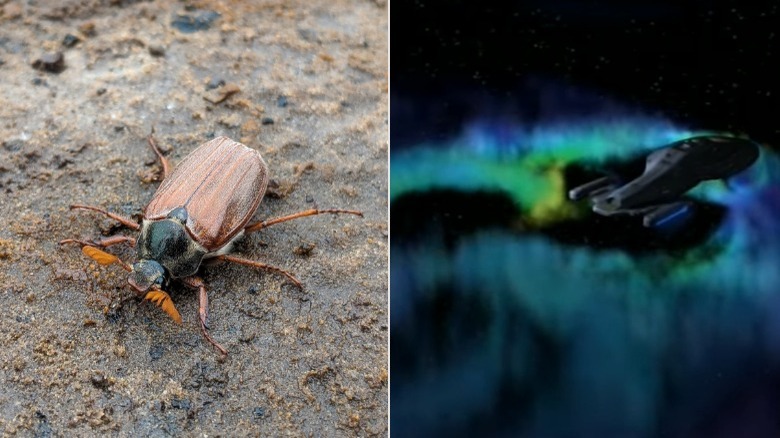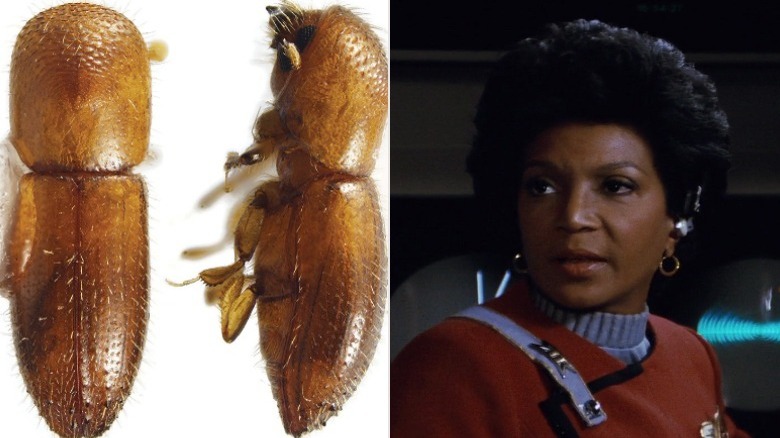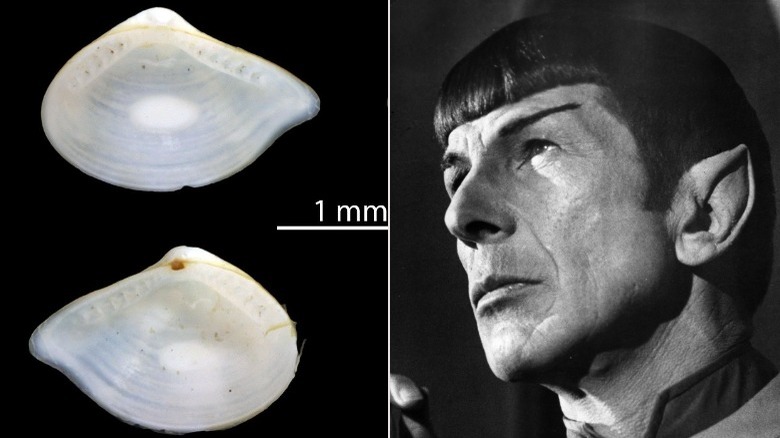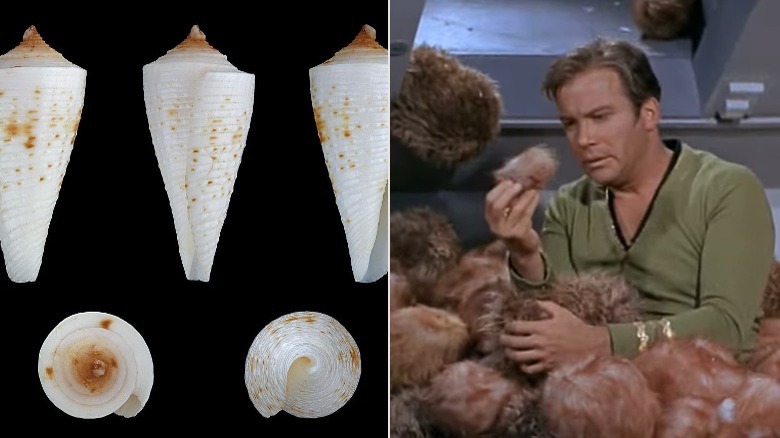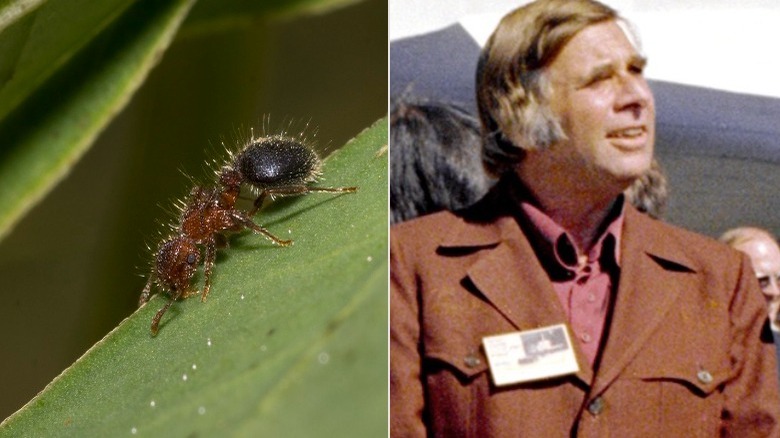Times Real Species Got Their Names From Star Trek
It shouldn't come as a surprise to anyone that scientists are a bunch of nerds. (Aren't we all, though?) It's almost a given, and there's probably not that much of an explanation needed there. So it also kind of makes sense that, when given the chance to name something that will be remembered forever, some scientists decide to reach for references from popular culture. And given the wide reach and influence that the "Star Trek" franchise has – with its numerous shows, movies, and animated cartoons stretching across multiple decades – it's wormed its way into some real life science.
So then, when you take a look at biology and all of those really long, really complicated Latin-based names and consider the fact that literally thousands of distinct animal species can be discovered in just one small area of the globe over the course of a couple of decades – well, that would be a perfect place to make some sneaky references. Entirely unsurprisingly, some scientists have done just that, working fun "Star Trek" references into their professional research. These are a few of the times that real species have gotten their names from "Star Trek."
Phanuromyia odo
If you've never heard of it, "Star Trek: Deep Space Nine" has long been considered the black sheep of the family, when it comes to the "Star Trek" franchise (via IGN). That said, it's got its own, very devoted, fanbase which loves the show for telling new stories surrounding their fantastic cast of characters. But even among that unique cast, the station's ever-gruff chief of security, Odo (played by Rene Auberjonois), stands out. Aside from being a well-written character (like the rest of the show, overall), Odo isn't human, nor is he even humanoid. Rather, he's a shapeshifter, capable of taking on any form, though his natural state is basically a pool of liquid.
He's a memorable character with a memorable concept, so is it any surprise that some nerdy scientists decided to name a species after him? The species in question: Phanuromyia odo. According to Live Science, this new species of wasp was discovered in 2017, just one of a number of new members to a family of wasps known for a pretty gross way of coming into the world. Namely, these insects are known for laying their eggs inside of a host insect, which is then consumed from the inside out by the baby wasp.
All of these newly named wasps have fun, pop culture-inspired names, but, according to the original paper, the researchers decided to invoke "Star Trek" in this case due to this species' "variable morphology." In other words, individual wasps of the same species can all look very different, even to the point that the researchers thought they were dealing with multiple species of wasp, rather than just one.
Annuntidiogenes worfi
"Star Trek: The Next Generation" is undoubtedly iconic, as are all of its characters. After all, Patrick Stewart's Jean-Luc Picard went on to get his own new show decades later (quite the legacy), and Rotten Tomatoes has it tied for the top spot, rankings-wise, among the entire franchise. The show it's tied with: "Deep Space Nine." And, funnily enough, one of those famous "Next Generation" characters went on to star on both of those shows – everyone's favorite Klingon warrior, Worf, played by Michael Dorn.
And just what kind of animal is worthy of sharing a name with such a character? Well, a hermit crab, apparently. A Cretaceous-era crab, more specifically. A 2009 article published in the Boletín de la Sociedad Geológica Mexicana discussed paleontological fieldwork that was being done in quarries and age-old, dried-up reefs located in northern Spain. Various different kinds of now-extinct organisms had been cataloged in the area in the past, but the researchers happened upon an especially unique fossil – the only one of its kind, in fact. And the most prominent feature was an oddly wrinkled region, one that reminded them specifically of Worf's forehead. And so the appropriate name was pretty obvious: Annuntidiogenes worfi.
Klingon newt
The Klingons have been a regular presence across all of "Star Trek," making appearances as far back as the original show, throughout the slew of shows that came out in the '90s, and in this more recent revival of the franchise. That said, per Inverse, not everyone is apparently in agreement on that last point, what with "Star Trek: Discovery" giving the race a bit of a redesign that not all fans are exactly on board with. Still, the showrunners did keep the iconic forehead ridges that the Klingons are known for among the entire fanbase.
Plenty of scientists also seem to be fans, because according to National Geographic, researchers working in the Greater Mekong area of Asia in 2015 clearly had "Star Trek" on their minds. PopSci explains that the general area is well known for its incredible biodiversity – and thus a large number of new animals that are just waiting to be discovered. That particular research trip uncovered over 160 new species in that year alone – for a total of 2,500 over the past 20 years – many of which can only be found in that particular region of the globe.
Now, for the "Star Trek" connection: one of the animals discovered was the Tylototriton anguliceps, more playfully known as the Klingon newt. One of multiple newt species discovered, these little guys got their name from the unique pattern of ridges marking their skull, which seemed rather reminiscent of the trademark look of their alien namesake.
Agra dax
"Star Trek: Deep Space Nine" really does a rather impressive job of showcasing quite a few alien races that don't quite get as much screen time in some of the more widely popular parts of the franchise. There are a number of races that crop up occasionally in other shows, and one of those races is the Trill, introduced in "Star Trek: The Next Generation" but expanded upon through the characters of Jadzia and Ezri Dax (played by Terry Farrell and Nicole de Boer, respectively).
But returning to Earth for some real-life science, the story turns to entomologist Terry L. Erwin. According to an interview conducted with Erwin by Marlin E. Rice, Erwin's time as a student basically saw him determined to study his favorite thing: beetles. He studied under the foremost names in the field, and one sneaky change to his grant proposal later, he found himself headed to Central America to study the biodiversity of beetle life.
While his research centers on all sorts of beetles, he does admit (rather readily) to having a favorite: Agra dax. A carabid beetle found in Panama, Agra dax is known for its bright, metallic green color, and Erwin is so fond of the beetle that he even uses its name as his license plate number. He also explicitly drew the connection between his favorite beetle and Jadzia Dax; Terry Farrell is "absolutely beautiful," per his own words, so the reference just made sense to him.
Xenaroswelliana deltaquadrant
"Star Trek: Voyager" truly took its cast where no man had gone before. While most of the "Star Trek" shows tend to play around in the sandbox of lore related to the famous Alpha Quadrant, "Voyager" decided to throw its cast a curveball by shunting them across the galaxy. All of a sudden, the crew of this spaceship truly had to fly blind, navigating their way through unknown territory and meeting species that are truly alien, even by "Star Trek" standards.
Entomologist Terry L. Erwin described some of his work in a 2007 article, in which he was cataloging a number of different beetle species, in some cases even naming them for posterity's sake. However, in the process, he also happened upon a species of beetle that didn't seem anything like those he had worked with in the past. His paper makes it clear there's not much known about this particular species, one of which he decided to call Xenaroswelliana deltaquadrant. The first part of the name derives from Greek roots, but the second pulls from "Voyager," with the Delta Quadrant being the region of the galaxy that the cast found themselves in. Erwin chose the name specifically as a reference to the mysterious "Species 8472," which hails from a parallel, "fluidic" universe. The exact way that this "fluidic" universe works isn't understood in-universe, and it's the confusion that Erwin had in mind while naming the beetle. After all, he admits that very little is actually known about it.
Coptoborus uhura
You can't really top the original "Star Trek." The adventures of Captain Kirk and the crew of the Enterprise as they explored the far reaches of "space, the final frontier" – whatever your view is of which show is actually the best, you can't deny the fact that this is the show that started it all. It's amassed a huge following, and its cast will likely be forever known for their part in this long-lived legacy, bringing life to these famous characters. One of those characters? Nyota Uhura, the communications officer on the bridge of the Enterprise, played by Nichelle Nichols (and by Zoe Saldana in the newer films).
Now, for the real life science. According to U.S. Free News, two entomologists from the University of Michigan – Sarah Smith and Anthony Cognato – were doing work in Central and South America, where they discovered more than 30 new species of ragweed beetle, none of which had been documented before. And they decided to have fun with the names, settling on a theme for many of them: sci-fi heroines.
That list included quite a few popular characters – Katniss Everdeen from "The Hunger Games," Dana Scully from "The X-Files," and, of course, Nyota Uhura (via MSU Today). To get a little more specific, Coptoborus uhura got its name due to its deep red coloration. Smith and Cognato were reminded of the red uniform Uhura sported on the show, and they felt it was a good fit.
Ledella spocki
If you were to get into a conversation about the most famous "Star Trek" characters, there are a handful of names you're likely to hear tossed around. Obviously, there are all the captains of each of the respective shows; Kirk and Picard are widely known and loved. But if you step outside of the captains, then, undoubtedly, another famous name you'll hear around is Spock, the first officer and science officer of the USS Enterprise, played by Leonard Nimoy. After all, who hasn't heard "Live long and prosper"?
So it's only natural that Spock would be one of the characters who has also gotten a real-life animal species named after him. In this case, it's the mollusk known as Ledella spocki. As described in a 2014 article published in the American Malacological Bulletin, this mollusk was one of a group discovered deep in the ocean off the coast of Brazil (the only place, apparently, where these mollusks can be found at all). Researchers took a look at the overall shape of this particular species, noting the pointed look it had, and it ended up reminding them of the pointed ears of the Vulcans. Given that Spock is the best known member of that race, of course the honor had to go to him when it came to naming.
Conus tribblei
"Star Trek" has plenty of stand-out episodes (but, really, is that any surprise, given that the franchise has been around for decades and is immensely popular?) Everyone has certainly got their favorites, but "The Trouble with Tribbles" is one of those episodes that's beloved by just about everyone who's a fan of the show. If you're not familiar with the plot, in effect, the cast is met by the least threatening menace you could ever imagine: a bunch of furry little hairballs. The catch? After they eat, they multiply and reproduce like mad, making their way into every crack and crevice of the space station the crew has docked at.
You'd probably imagine, then, that Conus tribblei is some sort of fuzzy animal, then, right? Well, not really. Conus tribblei (or Tribble's Cone, according to the British Shell Club) is actually a type of mollusk that makes its home in conical shells colored with a mix of white and brown (via World Register of Marine Species). Oh, and according to a 2015 article, they're also venomous predators. A far cry from the fluffy aliens from the TV show, right? So what's up with that?
As it turns out, the mollusks got their name in a somewhat roundabout way. Jerry Walls, the researcher who discovered the mollusk, was actually naming them after his "favorite cat, Tribble, who in turn was named after the featureless balls of fur made famous" in "Star Trek" (via British Shell Club).
Meenoplus roddenberryi
In general, when you hear that there are species that get their names from a fictional work such as "Star Trek," you'd probably imagine that the inspiration is coming from the names of fictional people and places. But, in this case, it's a little different. Rather than pulling from the TV show itself, researchers decided to pull inspiration from the man behind the show – Gene Roddenberry.
A 2012 article published in Deutsche Entomologische Zeitschrift described the discovery of "an obligate cavernicolous and highly troglomorphic meenoplid species" on the Canary Islands. That's a lot of confusing words all strung together, so The Guardian simplifies things. In short, it's a type of cave-dwelling bug. But what makes it cool is the fact that it actually lives in caves and tunnels created as a result of volcanic activity on the Canary Islands – more specifically, it was found in an area that was long thought to be almost devoid of distinct types of life. Beyond that, researchers don't even know what its actual origins are, only guessing that it has ties to now-extinct species. In short, there really doesn't seem to be anything like it.
As for the reason it gets to have Roddenberry as a namesake: the researchers cited the famous phrase, "to explore strange new worlds, to seek out new life ... to boldly go where no man has gone before," saying that it could apply to biology as much as it did to space exploration. In effect, the discovery of this strange bug was no different than discovering a new world or new alien race, thus keeping it in line with Roddenberry's meaning when he coined the phrase.

